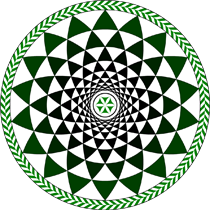Speaker
Dr
Alžbeta Orendáčová
(P. J. Šafárik University, Košice, Slovakia)
Description
`The model of a spin 1/2 Heisenberg antiferromagnet (HAF) on the square lattice with nearest-neighbor coupling, $J$, represents an important paradigm of a two-dimensional (2D) magnetism. It represents a limiting case of more complicated 2D systems with the spatial anisotropy, $R$. The simplest example is a model of a rectangular lattice comprising of a 2D array of chains coupled by the inter-chain coupling $J’$. While the properties of the spatially isotropic square lattice ($R=J’/J=1$) have been intensively investigated, the aforementioned spatially anisotropic analog with $R < 1$ has not received so much attention. The lack of corresponding theoretical predictions and difficulties with preparation of such materials did not allow finding proper experimental realizations of the HAF square lattice with $R < 1$.`
`Our work is focused at the theoretical and experimental investigation of spin and exchange anisotropy in Cu(en)SO$_4$(H$_2$O)$_2$ (CUEN). This quasi-2D quantum magnet with spin 1/2 was previously identified as a representative of a spin 1/2 HAF on the spatially anisotropic triangular lattice with the Neel ground state [1]. First-principle calculations of exchange interactions in CUEN revealed that the system can be treated as a 2D array of zig-zag chains forming a zig-zag square lattice. To confirm this expectation, using quantum Monte Carlo (QMC) simulations, the behavior of the model at finite temperatures was investigated. In parallel, single-crystal experimental studies were performed involving specific heat, susceptibility and magnetization measurements. The analysis of the data revealed excellent agreement with the QMC predictions; the 2D correlations in CUEN approximate those of spin HAF zig-zag square lattice with $R = 0.35$. While a spin anisotropy of the order $10^{-3} J$ has a negligible effect on the finite-temperature properties of 2D lattice, the onset of long-range order set at 0.93 K is highly sensitive to the presence of the weak spin anisotropy. A symmetry constraints within the magnetic layer expected only symmetric exchange anisotropy with an easy-axis breaking symmetry within the easy plane. Correspondingly, a spin flop (SF) within the easy plane should occur in the field applied along the easy axis. The expectation was confirmed by magnetization studies at 0.5 K which revealed the SF in the field 200 mT. It was shown that sufficiently strong magnetic field can overcome the intrinsic spin anisotropy and the field can introduce an easy-plane anisotropy with the easy plane perpendicular to the magnetic field direction. Finally, the magnetic phase transitions in the applied field show universal behavior independent of the field orientation, mimicking the scenario of the field-induced Berezinskii-Kosterlitz-Thouless phase transition [2].`
`Projects VEGA 1/0269/17, DS-2016-0046, APVV-14-0078 and APVV-14-0073 are acknowledged.`
`References`
[1] M. Kajňaková, M. Orendáč, A. Orendáčová, A. Vlček, J. Černák, O.V. Kravchyna, A.G. Anders, M. Balanda, J.-H. Park, A. Feher, M.W. Meisel, `$\textit{Phys. Rev. B}$` `$\textbf{71}$`, 014435 (2005).
[2] L. Lederová, A. Orendáčová, J. Chovan, J. Strečka, T. Verkholyak, R. Tarasenko, D. Legut, R. Sýkora, E. Čižmár, V. Tkáč, M. Orendáč, and A. Feher, `$\textit{Phys. Rev. B}$` `$\textbf{95}$`, 054436 (2017).
Author
Dr
Alžbeta Orendáčová
(P. J. Šafárik University, Košice, Slovakia)
Co-authors
Prof.
Alexander Feher
(P. J. Šafárik University, Košice, Slovakia)
Dr
Dominik Legut
(Technical University of Ostrava, Ostrava, Czech Rep.)
Dr
Erik Čižmár
(P. J. Šafárik University, Košice, Slovakia)
Dr
Jaroslav Chovan
(M. Bel University, B. Bystrica, Slovakia)
Dr
Jozef Strečka
(P. J. Šafárik University, Košice, Slovakia)
Ms
Lívia Lederová
(P. J. Šafárik University, Košice, Slovakia)
Prof.
Martin Orendáč
(P. J. Šafárik University, Košice, Slovakia)
Dr
Robert Tarasenko
(P. J. Šafárik University, Košice, Slovakia)

